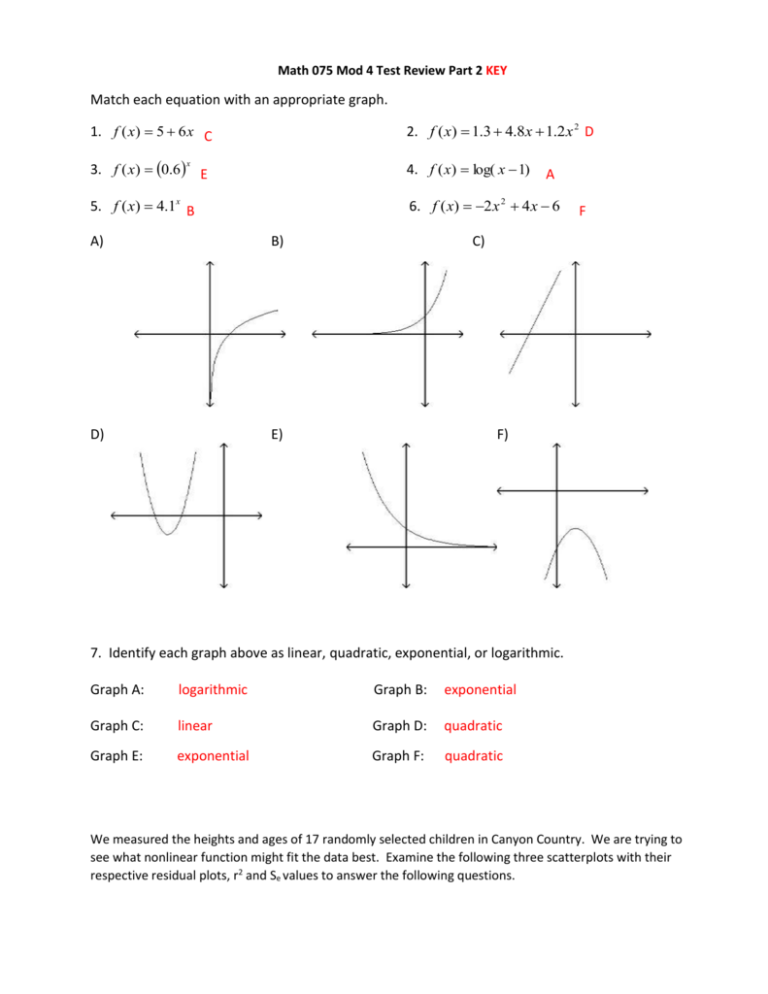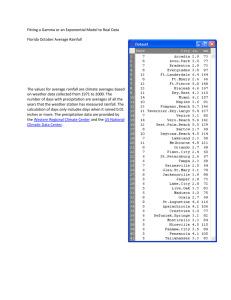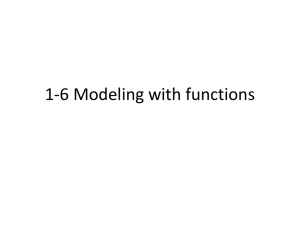Math 075 Mod 4 Test Review Part 2 KEY Match each equation with
advertisement

Math 075 Mod 4 Test Review Part 2 KEY Match each equation with an appropriate graph. 1. f ( x) 5 6 x C 2. f ( x) 1.3 4.8x 1.2 x 2 D 3. f ( x) 0.6 E 4. f ( x) log( x 1) 5. f ( x) 4.1x B 6. f ( x) 2 x 2 4 x 6 x A) B) D) E) A F C) F) 7. Identify each graph above as linear, quadratic, exponential, or logarithmic. Graph A: logarithmic Graph B: exponential Graph C: linear Graph D: quadratic Graph E: exponential Graph F: quadratic We measured the heights and ages of 17 randomly selected children in Canyon Country. We are trying to see what nonlinear function might fit the data best. Examine the following three scatterplots with their respective residual plots, r2 and Se values to answer the following questions. Quadratic Model: y = 15.61 + 4.13x – 0.07x2 r2 = 95.7% , Se = 2.51 inches Fitted Line Plot Child Height in Inches = 15.61 + 4.132 Child Age in Years - 0.06966 Child Age in Years^2 Child Height in Inches 70 S R-Sq R-Sq(adj) 2.51353 95.7% 95.1% 60 50 40 30 5.0 7.5 10.0 12.5 15.0 17.5 Child Age in Years r2 = 93.3% , Se = 3.04 inches Logarithmic Model: y = -6.08 + 24.87*ln(x) Fitted Line Plot Child Height in Inches = - 6.076 + 57.27 log10(Child Age in Years) Child Height in Inches 70 S R-Sq R-Sq(adj) 3.03582 93.3% 92.8% 60 50 40 30 5.0 7.5 10.0 12.5 15.0 17.5 Child Age in Years Exponential Growth Model: y = 27.86(1.06)x r2 = 94.0% , Se = 0.03 inches Fitted Line Plot log10(Child Height in Inches) = 1.445 + 0.02326 Child Age in Years Child Height in Inches 70 S R-Sq R-Sq(adj) 60 50 40 30 5.0 7.5 10.0 12.5 Child Age in Years 15.0 17.5 0.0256744 94.0% 93.5% 8. Analyze criteria for regression. a) Does the data analyze two quantitative variables? If so, name the explanatory and response variable. Yes, the two variables are data that is being measured and numerical in nature. The explanatory variable is the child’s age and the response variable is the child’s height. b) Are there any influential outliers? If so, list as ordered pairs. No visible outliers c) Is the form of the scatterplot linear/curvilinear? In this case it does appear to be curvilinear. However, looking at the data it appears that a linear model might also be a good fit even though the graph was not provided. 9. Fill out the following chart only for the three models given. Residual Plot (vs. x-values or Versus Fit) [What do you see? Describe the shape: oval, band, fan, U-shape, Sshape, etc.] r2 se Parabola opening down, crosses horizontal axis twice 94.0% Does not apply Quadratic Wave, crosses horizontal axis three times 95.7% 2.51 in Logarithmic Wave, crosses horizontal axis three times 93.3% 3.04 in Model Linear Exponential (growth) Exponential (decay) 10. Did the exponential, logarithmic or quadratic function fit the data best? What statistical evidence did you base this on (residual plot, r 2 , se )? The quadratic model is the best. It has the highest coefficient of determination ( r 2 ) and the lowest standard error ( se ). The residual plot is more random than the exponential model. (The logarithmic residual plot is not significantly better.) 11. Interpret the meaning of r2 = 95.7% in context to the above problem (from the quadratic function). 95.7% of the variation in the height of a child can be explained by the quadratic model. 12. Interpret the meaning of Se = 2.51 inches in context to the above problem (from the quadratic function). One can expect an error of 2.51 inches when predicting the height of a child. 13) Write the model equation and make the following predictions. a. Use the exponential function to predict the height of a child 8.5 years old. 45.7 inches b. Use the log function to predict the height of a child 13 years old. 57.7 inches (Note: the model is in base e, the natural log. Use the ln button on your calculator instead of the log button.) c. Use the quadratic function to predict the height of a child 16.5 years old. 64.7 inches d. Can we use any of the functions to predict the height of a 28 year old adult? Why or why not? No, it is beyond the scope of the data. (Extrapolation) We don’t know if the pattern would continue beyond the ages that were provided. e. Can we use any of the functions to predict the height of a 5 year old? Why or why not? 5 years old is within the scope of the data. Therefore, you could use a ‘good fit’ model to make predictions. In this case, one would use the best fit model that is available which was the quadratic model. 14. Let’s look again at the children’s age and and height data. Describe each of the following sentences as valid or invalid and explain why. One of three residual plots is shown. a) The least amount of error would occur when predicting the height of a child that is 4 years old. Invalid. There are other ages where the error is less for example at 10 and 11 years old among others. (In other words, there are other points that are closer to the x axis.) b) As the age increases, the amount of error when making predictions decreases. Invalid. The error is less between the ages of 4 and 9 and increases as the child gets older. c) The greatest amount of error would occur when predicting the height of a child that is 12 or 17 years old. Valid. The error is around 6 inches for both ages which the largest error on the plot. (In other words, these two points are the furthest from the x axis.) d) A se of 2.51 indicates that there is an average error of 2.479 years in age when making predictions. Invalid. The standard error is the error when making predictions on the response variable which is the height in this case. e) A se of 2.51 indicates that there is an average error of 2.479 inches in height when making predictions. Valid. The standard error is the error when making predictions on the response variable which is the height in this case. f) The best fit model can be used to predict the height of a child from 1 to 17 years old. Invalid. The scope of the data is from 4 to 17 years old. g) The residual plot shows a pattern. Therefore, the corresponding curvilinear function would be appropriate to use to make predictions. Invalid. If the residual plot shows a pattern then this suggests that there might be a more appropriate model that would be a better fit. A residual plot that does not show a pattern suggests that our model is appropriate to use to make predictions. 16. Short essay: Be prepared to be able to compare and analyze curvilinear models and identify the best fit based on statistical evidence. Don’t forget to quote the actual statistics in your essay to support your interpretations. Also, know how to interpret se and r 2 in context to the data provided.









